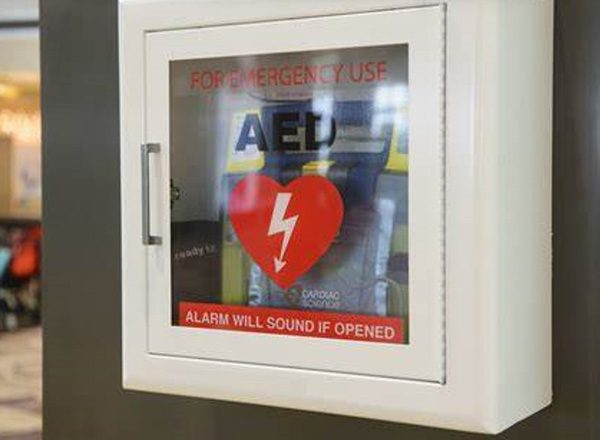Why is rapid defibrillation important? In emergency medical care, the question isn't just a theoretical one — it's a matter of life and death.
Rapid defibrillation plays a pivotal role in the chain of survival. Several factors influence the success of rapid defibrillation, and more is being learned about this crucial link in the chain of survival. Having a firm understanding can make a difference in emergency situations both inside and outside the hospital.
We sat down with Dr. Andrew Latimer of Harborview Medical Center in Seattle to discuss the significance of early defibrillation, its impact on saving lives and the evolving landscape of this lifesaving intervention. Here are the valuable insights and knowledge he shared during the discussion.
Q: What is the chain of survival in emergency medical care, and why is rapid defibrillation important?
The chain of survival in emergency medical care is a metaphor for the interconnected elements of an emergency care system for victims of sudden cardiac arrest. According to the American Heart Association, the six links in the chain of survival for adult out-of-hospital cardiac arrest (OHCA) are:
- Recognition and activation of the emergency response system
- Early and high-quality CPR
- Rapid defibrillation
- Advanced resuscitation by EMS
- Post-cardiac arrest care
- Recovery
Rapid defibrillation, the third step, is crucial because it delivers an electric shock to the heart in a timely manner, restoring a normal rhythm during sudden cardiac arrest and significantly increasing the chances of survival.
Laerdal offers a wide variety of products to support every aspect of education for healthcare providers in these critical scenarios, with a focus on collaborative training to ensure an effective team approach.
Q: What is the significance of rapid defibrillation in the context of sudden cardiac arrest?
For every minute that a person's heart is in ventricular fibrillation (the cardiac rhythm that defibrillation treats), their chances of survival drop by roughly 10%. After 10 minutes in VF without defibrillation, a patient's chances of survival are essentially zero.
Q: How does it differ from other interventions like CPR?
Other interventions such as high-quality chest compressions can prolong this time, but ultimately the goal of high-quality CPR is to bridge a patient to defibrillation and return to normal heart rhythm and spontaneous circulation. Defibrillation can be the definitive treatment for patients with sudden cardiac arrest from ventricular fibrillation and goes hand in hand with CPR.
Q: What factors influence the success of rapid defibrillation in emergency situations?
The key factor that influences the success of rapid defibrillation in sudden cardiac arrest is the time from the onset of arrest to the application of defibrillation. This is influenced by many things, such as early recognition of arrest, rapid availability of public access automated defibrillation technology and/or rapid response of EMS providers with defibrillators.
Q: Why is rapid defibrillation important while performing CPR?
The success of defibrillation is highly dependent on the quality and timeliness of CPR provided prior to the application of the defibrillator. Rapidly applied and high-quality CPR can sustain some patients in cardiac arrest to effective defibrillation if done effectively.
Q: How can medical organizations ensure timely access to defibrillators?
Healthcare institutions and communities can ensure timely access to defibrillators by:
- Building and maintaining a robust network of publicly accessible automated external defibrillators (AEDs)
- Utilizing crowd-sourcing technologies (such as GoodSam and Pulsepoint) to leverage bystander response to OHCA victims in our communities
- Supporting strong evidence-based EMS systems that focus on OHCA care and the chain of survival with a specific focus on early recognition, telecommunicator CPR (T-CPR) and rapid dispatch of EMS resources to OHCA victims
Q: Can you share some examples to highlight the lifesaving impact of early defibrillation?
The common implantable cardiac defibrillator is a great real-life example. Many Americans live their lives with heart disease and conditions that predispose them to malignant cardiac arrhythmias such as ventricular fibrillation.
These patients can live safely in the community because when they go into VF, the implanted defibrillator device immediately detects the rhythm and applies defibrillation via the implanted electrodes. Because this is done rapidly — often within seconds — these defibrillation attempts are essentially universally effective.
Q: Looking ahead, how do you see the role of rapid defibrillation evolving in the chain of survival?
I think we will see emerging technologies assist in improving the rates of rapid application of defibrillation technology. The first and possibly biggest impact may be utilizing machine learning technologies in the dispatch center to help telecommunicators rapidly identify out-of-hospital cardiac arrest victims and coach bystander CPR.
Q: Are there developments or ongoing research projects that may further enhance its impact on saving lives?
Several pilot studies have demonstrated the potential feasibility and efficacy of drone-delivered AEDs in certain suburban/semirural areas where access to public AEDs is limited and ground EMS response times are longer.
A technological development that has a strong chance to change the rates of early out-of-hospital defibrillation is the advent of inexpensive, readily available public AEDs that individuals could purchase and place in private homes.
Q: How is rapid defibrillation incorporated into the RQI Program? How can this help in scenarios outside of the hospital?
Rapid defibrillation is a critical component of the Resuscitation Quality Improvement (RQI) Program, which is designed to enhance the quality of CPR and improve outcomes for patients in and outside the hospital.
The RQI Program incorporates rapid defibrillation by providing healthcare professionals with low-dose, high-frequency training and practice on AEDs. RQI Simulation Stations provide self-directed, real-time audio and visual feedback to help clinicians provide the highest-quality CPR to improve survival outcomes.








